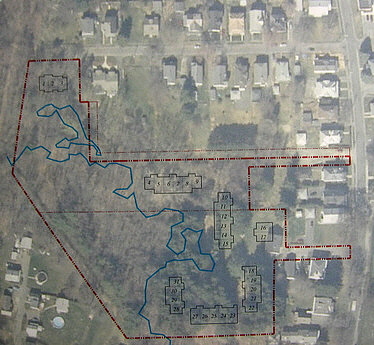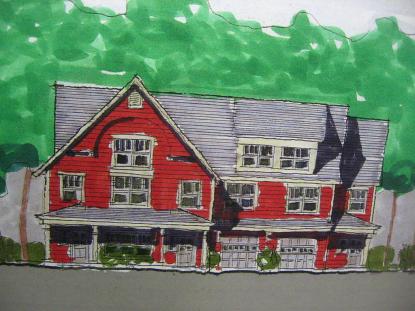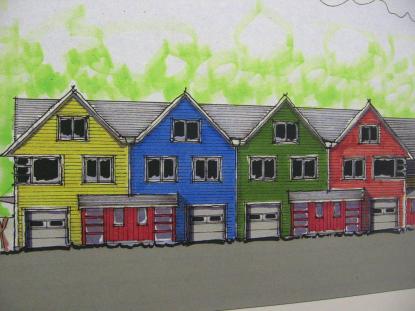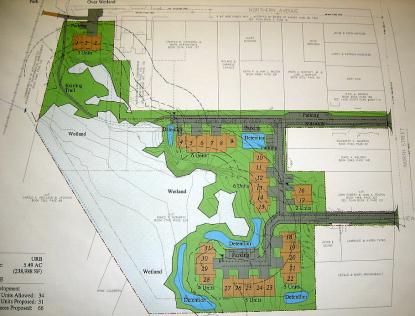It’s great to read everyone’s posts on the Paradise City Forum listserv regarding the North Street Condominium proposal and Smart Growth. In my view it would help to integrate the three different though not necessarily exclusive components I’ve been considering with regards to the North Street area development issue, Urban Planning, Public Policy, and Urban Ecology.

Overview of Kohl proposal, courtesy North Street Neighborhood Association
According to Webster’s online dictionary Urban Planning is defined as, "1. The branch of architecture dealing with the design and organization of urban space and activities. 2. Determining and drawing up plans for the future physical arrangement and condition of a community."
From the same dictionary Public Policy is defined as, "an attempt to identify and act upon the behavior of groups of human beings. Usually the actor is a government, and its usual goals are to increase the wealth and power of the rulers and wealthy, hopefully also increasing the health and well-being of the general society. The crucial, central part of Public Policy is to try to assure that the interests of wealthy and powerful people are never aided by pain, misery or suffering in other groups. There are some general rules of thumb about how this should be accomplished: Freedom of the press, republican government (not Republican), government of law, a free market, adoption of positive economies of scale, military defense, health and safety, progressive taxation, and science policy."
Finally, Webster’s defines the third component of which I write,Urban Ecology as, "the study of an area’s residents to understand what natural resources the community has available, and with this knowledge provide the opportunity to restore and protect these resources. It also involves studying the effects of urban development patterns on ecological conditions. Emphasis is also placed on planning communities with environmental sustainable design to promote a healthy and biodiverse urban ecosystem."
Site of proposed duplex at the end of Northern Avenue
After reading the various recent PCF entries on the North Street area dilemma, I feel that these three components are intermingling somewhat and that people are arguing from different contexts and parochial vantage points. Theoretically, few can argue successfully against the positive external effects of "Smart Growth" as a planning instrument. However, the Kohl development on North Street will probably not closely mimic dense older urban neighborhoods in any country, and it will cost us part of an urban forest as well. Look at the schematic below and tell me that this proposed development is the best that can be done with regards to Smart Growth. It appears to me as a tightly clustered residential sprawl-development moved into town with basically a token nod toward Smart Growth principles, that is it’s close to town and it’s clustered.
Recently discovered vernal pool
I tend to agree though, that development in town near commerce and infrastructure, by itself, makes sense. However, there are many other factors at play here that are not being addressed. For example, Joel Russell has written of the North Street project as an infill project. While this is true, it does fall short of various Smart Growth goals. For instance it is single-use, to my knowledge the units are to be market rate therefore they will not be diversified by social class, there is a good deal of impervious surface created that wasn’t there before, and the units don’t face the street per se, as there isn’t one. The units face away from the asphalt toward the woods for the most part, and there is not a traditional roadway involved but rather parking lots linked together.

Condominium units face inward, away from parking lot roadway
It is not likely that this development will promote the kind of lively streets in its vicinity that Smart Growth proponents traditionally envision and the nearby wetlands will probably be blamed for any flooding problems that might manifest themselves. Moreover, I have not been able to find definitions of infill that include removing viable greenfields, though they may exist. Generally infill seems to concern redeveloping previously developed areas, vacant lots,or brownfields and rehabilitating historic buildings. Thus obscured from the recent debate has been the importance of maintaining Northampton’s Urban Ecology, which enhances the quality of life of intown dwellers, human or otherwise.
Pine forest slated for removal
I argue further that the types of policies that are being adopted in Northampton and how they are being adopted goes beyond Urban Planning theory. The way a community develops is at least as much about its political infrastructure as it is about its planning. Please note the State Hospital, the Education Use Overlay District and the Hilton Garden Inn processes as well as the reliance on an unscientific city survey in crafting the Sustainability Plan for examples. The fact that Douglas Kohl and Adam Cohen involved themselves in the debate about the Wetlands Ordinance speaks volumes about the setting of Northampton’s policies as people often have differing interpretations as to what "Smart" means. As well, examination of the preferences of current Conservation Commission members will reveal how the new Wetlands Ordinance is to be applied. One group of members could apply the law more restrictively than another, depending on the politics of the process.
View Avenue home slated for removal
Regarding NIMBYism, someone correct me if I’m wrong on this, but there is no small irony in the fact that several years ago residents of the Elm Street area successfully resisted a rezoning effort lead by city officials and defeated a proposal that would have allowed the building of multi-unit homes in those neighborhoods. Perhaps it is time to revisit that decision of exemption and bring the Elm Street area in line with the rest of downtown and make it subject to this same type of infill development that all of the other downtown neighborhoods are now subjected to. That is a measure of social justice that the city could adopt so that discussions of this nature would occur with greater equity.
Nearby wetlands flora
Adam Cohen wrote of people leaving Northampton in order to live in a fashion Northampton officials would like to restrict, thereby increasing sprawl outside of Northampton’s borders. There is a school of thought that supports this argument known as the Tiebout Model. Economics and Geography Professor Charles Tiebout wrote in 1956 about people "voting with their feet." That is, they will move to a community that taxes, spends, and sets policies more in line with their personal beliefs and preferences. While city officials commonly blame Northampton’s declining population on housing affordability, there may be other reasons that people are leaving as well, like political attitudes or municipal spending habits. Not everyone thinks of Northampton as Paradise, though I recognize some might view those words as blasphemy. In effect, Northampton could very well be seeing some resident turnover in part because those supporting policies framed and marketed as "Smart" are moving in, and those not supporting these policies are moving out, causing a net loss in population.

Artist rendering of proposed row house condominiums situated at the rear of parking lots
Also to clarify one of Bonnie Rose’s points, the Kohl North Street area development proposal includes row house condominiums set to the rear of parking lots, not free standing detached single family homes that front the "street," which would better match the existing neighborhood and is also a tenet of Smart Growth. According to Doug, Northampton zoning regulations require him to develop in such a fashion. There is a Condominium Association planned and the fate of the wetlands portion of Doug’s parcel remains undecided. It could be deeded to the Conservation Commission and come under the purview of the city with public access or it could remain privately held by the Condo Association which could restrict public access by right but would continue paying taxes on the land. Doug could include other covenants as well.

Above-Douglas Kohl has proposed eliminating units 27-23 and one of the three units shown in the upper left hand corner of the above schematic. Units 28-31 will be shifted further to the east reducing the size of the parking lot, and one unit will likely be added to the south end of the 18-22 bank of units. The total number likely to be proposed is now 26 units. The detention ponds as shown will also be altered, with the elimination of the rectangular pond show about center in the graphic, and the alteration of the three lower ponds as well, due to the relocation of the units.
From Joel Russell:
In Saratoga we used an innovative technique known as a form-based code: see http://www.formbasedcodes.org/. This is something that Northampton should definitely consider.
See also: http://www.newurbannews.com/ and http://www.bluebacksquare.com/ regarding the West Hartford project.
Another website worth visiting is the Congress for the New Urbanism: www.cnu.org ; also see the New England chapter at www.cnunewengland.org.
A new urbanist project in a small community is Warwick Grove in upstate NY: http://www.warwick-grove.com . This one is a huge success, and I refer my New York clients to it to visit and see for themselves how nice a well-designed high-density residential development can be.


